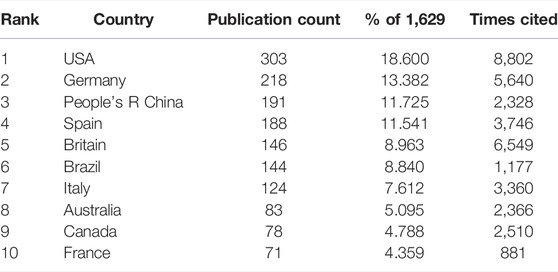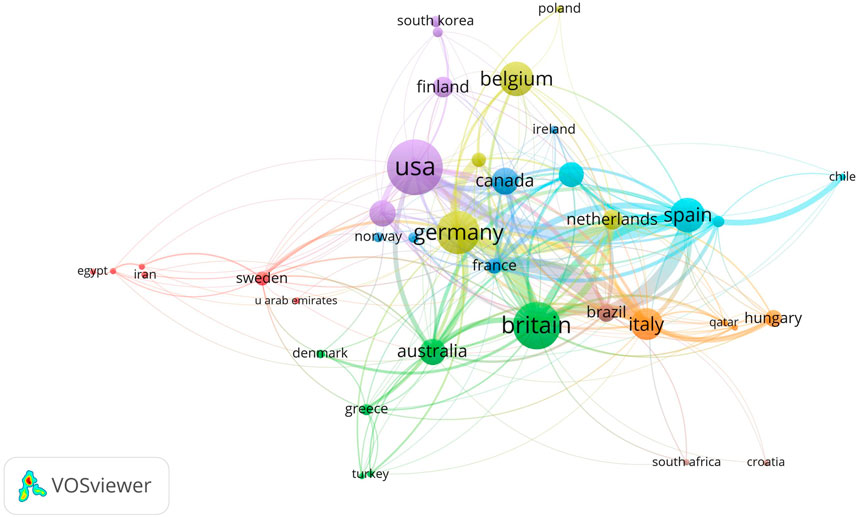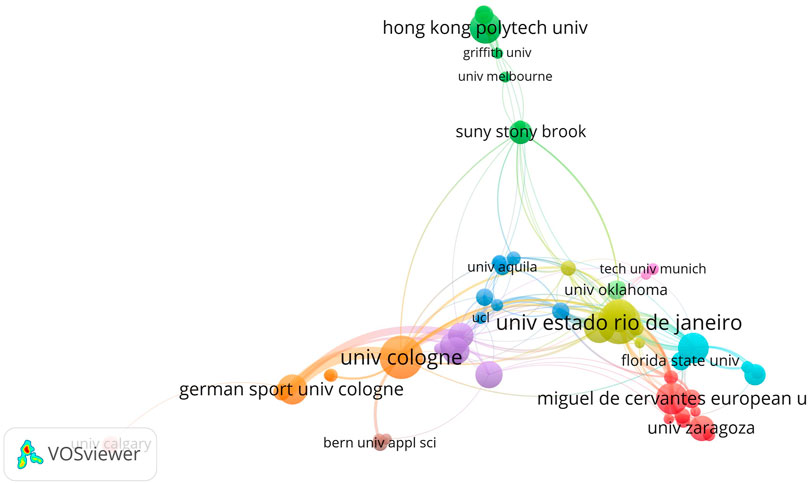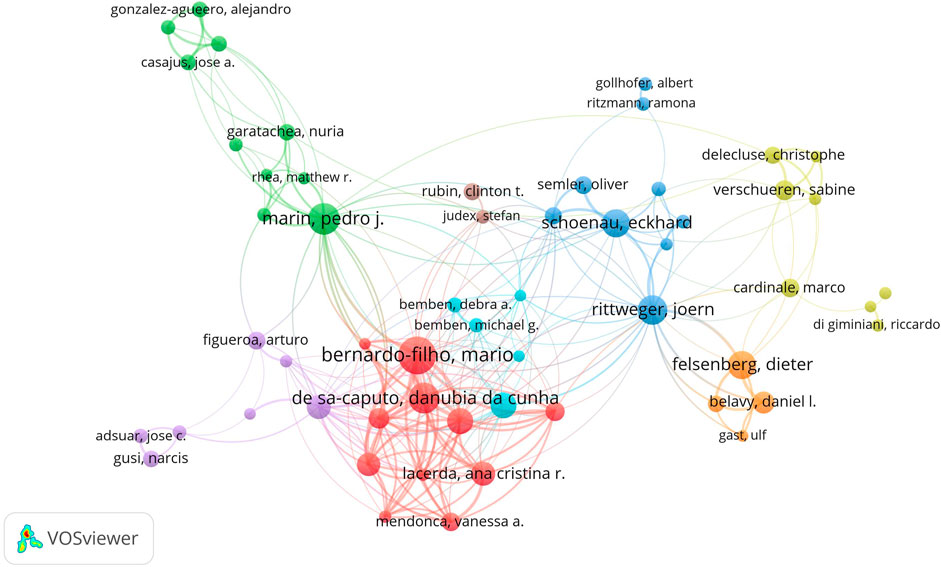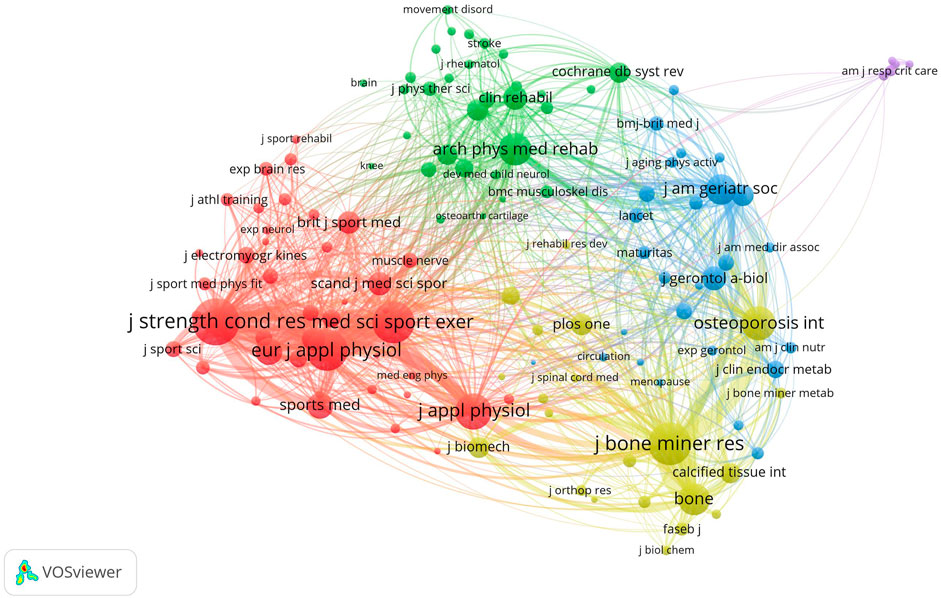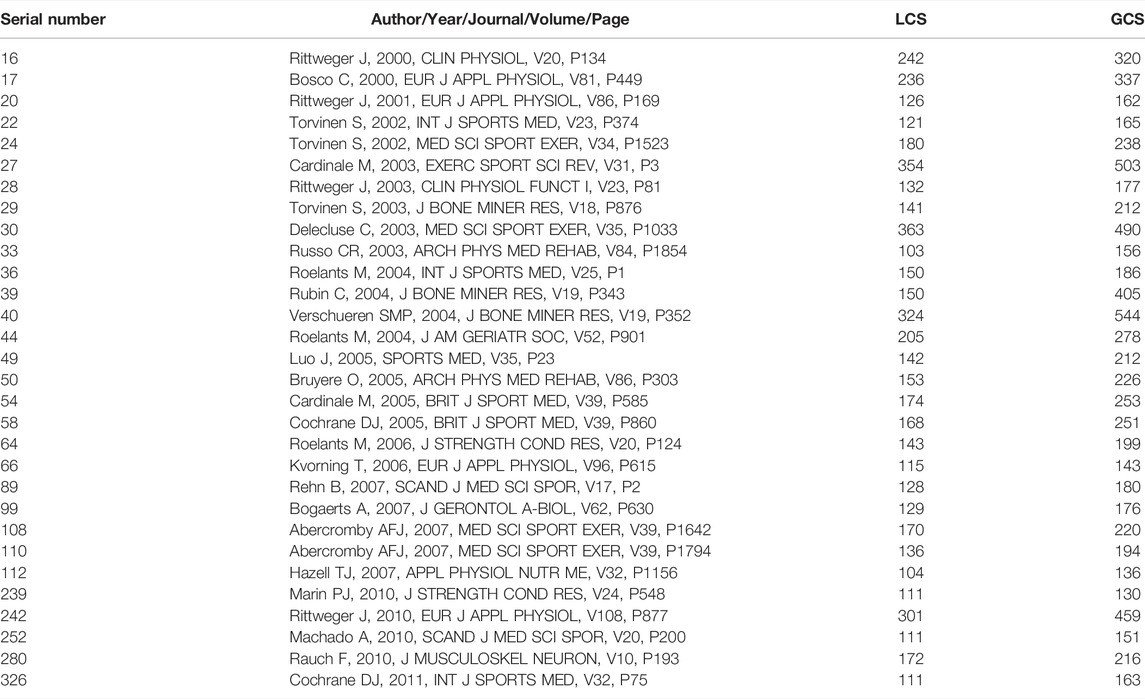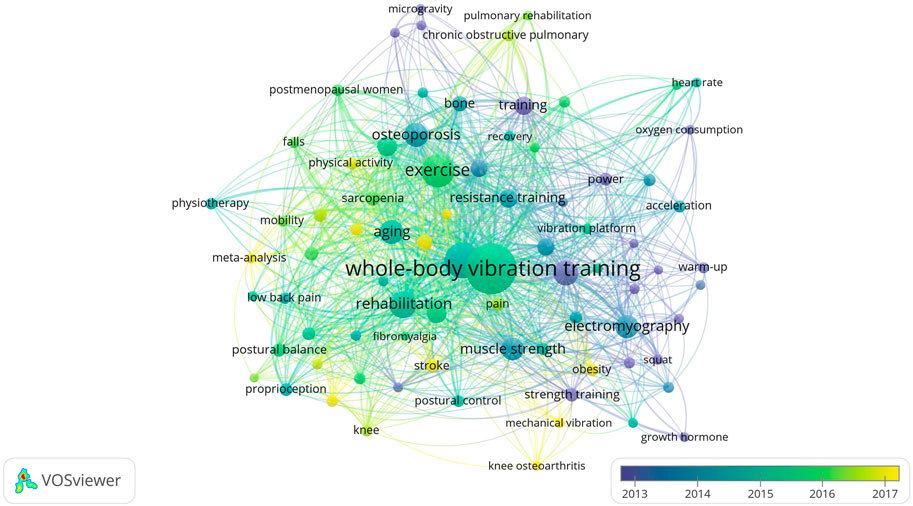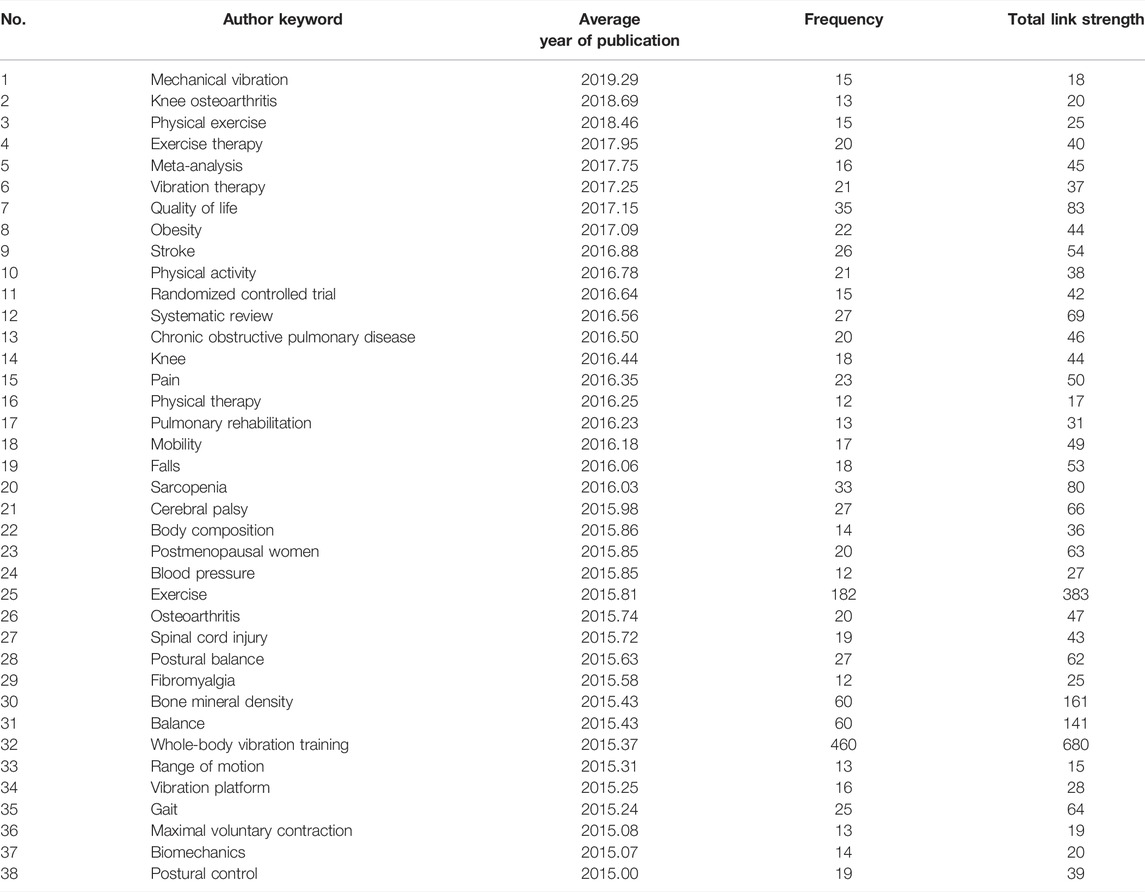- 1Department of Pathophysiology, College of Basic Medical Science, China Medical University, Shenyang, China
- 2School of Kinesiology, Shenyang Sport University, Shenyang, China
- 3Library of China Medical University, Shenyang, China
To evaluate the global scientific output of the research on whole-body vibration training (WBVT) and explore the current status and trends in this field over the past decades using bibliometric methods, we retrieved the literature related to WBVT from 2000 to the present in the Web of Science Core Collection (WoSCC). We analyzed annual publications, citations, countries, organizations, productive authors, and source 14 journals by the Web of Science online bibliometric analysis. We visualized the WBVT research trends and explored influential organizations and authors through VOSviewer. Then, we constructed a citation chronology map by HistCite to obtain the knowledge base of this field and made a primary citation path analysis by Pajek. Finally, we mined the hot spots of WBVT by BICOMB and gCLUTO. Overall, there were 1,629 publications included in this study between 2000 and 2022. The United States contributed the most publications in this field, and the country with the most active partnership was Spain. The University of Cologne ranked highest among top productive organizations. Bernardo-Filho, Mario, from Universidade do Estado do Rio de Janeiro, ranked first among the top productive authors. The Journal of Strength and Conditioning Research topped the list of journals with the most publications on WBVT by a wide margin. The WBVT research field started from Rittweger’s study on the acute physiological effects of WBVT in 2000, which was divided into two stages. The first stage focused on improving athletic ability, and the second stage gradually turned to the application in medicine. A keyword analysis showed the exercise rehabilitation of several aging chronic diseases was the research trend and hot spot of WBVT. The current study provided a time-based development and a global network hub for WBVT research, contributing to identifying core target diseases of WBVT and providing various insights for researchers in the future.
Introduction
Whole-body vibration training (WBVT), a non-invasive physical therapy, offers a passive exercise stimulation by vibration platforms and has become a reasonable procedure for enhancing muscular performance (Godinez et al., 2014; Annino et al., 2017). WBVT induces adaptive neuromuscular changes by producing biomechanical and physiological effects. Several factors determine its impact, including vibration mode and parameters and training posture and training frequency (Arias et al., 2009; Tankisheva et al., 2014).
WBVT is a standard training method for improving athletic performance and maintaining astronauts’ skeletal muscle mass and strength, which gradually becomes a focus in exercise rehabilitation (Song et al., 2019). Previous research has investigated the effects and mechanisms of WBVT for various medical conditions. Clinical studies indicated that WBVT could be applied to the rehabilitation of several chronic diseases including stroke, diabetes, osteoarthritis, and musculoskeletal pain (Wang et al., 2020; Rodríguez-Reyes et al., 2021; Wei and Cai, 2021; Qiu et al., 2022). Furthermore, fundamental research has investigated the underlying mechanisms of WBVT on muscle strength and performance, bone mineral content, and bone mineral density (Bleeker et al., 2005; Machado et al., 2010). Considering the increasing number and the diversity of published studies, an urgent bibliometric analysis on WBVT is needed to explore the hotspots and predict the future trends of WBVT research.
Bibliometric analysis is a useful tool for the quantitative and qualitative analysis of published academic literature for tracking hotspots and predicting future trends in a specific research field. It uses mathematical and statistical tools to enable the identification of influential publications, journals, countries, organizations, and researchers in a specific research area and assess their relationships and impacts (Van Eck and Waltman, 2010; Jain et al., 2015). It provides data to inform policymaking and clinical guidelines in the future (Zhao et al., 2018). Bibliometric analyses have been used to track hotspots and predict research trends in various fields, including exercise and rehabilitation (Park et al., 2020; Park et al., 2021; Xiang et al., 2021). With the rapid development in exercise rehabilitation techniques, growing attention has been concentrated on WBVT, and more and more articles on this topic have been published in recent years. However, there has not been any bibliometric analysis on WBVT until now. In the present study, we searched the studies on WBVT published during 2000–2022 and conducted a bibliometric analysis to dig the hotspots and predict the trends in this field.
Materials and Methods
Data Source and Acquisition Process
Given the consideration of the quality of the literature, as well as the requirement for reference format in 64 citation analysis (Gao et al., 2021; Wu et al., 2021a; Wu et al., 2021b), we adopted the Web of Science 65 Core Collection (WoSCC) (editions: Science Citation Index Expanded [SCIE], and Social Science Citation 66 Index [SSCI]) as the data source. Given the different English expressions of “whole-body vibration training,” this study referred to the keywords that were selected by relevant researchers to extract the literature related to WBVT effectively and tried to make the search results accurately include the research literature on WBVT in WoSCC. After multiple searches and comparisons, we finally determined the search formula as “TS = Whole-body Vibration Train* OR Whole body Vibration Train* OR Whole-body Vibration Exercise* OR Whole body Vibration Exercise* OR Whole-body Vibration Therap* OR Whole body Vibration Therap*) OR TS = (WBV NEAR Train*) OR TS = (WBV NEAR Exercise*) OR TS = (WBV NEAR Therap*) OR TS = (WBVT OR WBVE).”
On 7 May, 2022, the search command was carried out in the “advanced search” of WoSCC (SCIE and SSCI). In order to obtain the literature with a complete structure which was suitable for analysis tools, we selected document types as “Articles” and “Review Articles” in “Refine results” (Zhai et al., 2021). There were no restrictions on the languages, countries/regions, affiliations, journals, research areas, and Web of Science categories. A total of 1,883 initial publications since the 21st century were retrieved. The search results were independently screened by two researchers (MS and DD) in the related discipline, and all the discrepancies were resolved by the principal investigator (SX). We removed literature not related to medicine, sports, exercise, physical science, or rehabilitation, and literature mainly studying local vibration. We exported the final 1,629 literature records to a plain text file with “Full Record and Cited References.”
Analysis Tools and Research Methods
Bibliometric analysis, citation analysis, and content analysis were used to analyze the obtained literature. Bibliometrics mainly uses statistical and mathematical methods to study the external formal features of the literature to master the quantitative relationship, distribution structure, and development trend (Thompson and Walker, 2015). Citation analysis is an informetric method to analyze the citation and cited phenomena of scientific journals, publications, authors, and other analysis objects to reveal their quantitative characteristics and internal laws (Boyack and Klavans, 2010). Content analysis studies the content features of the literature, which is to analyze and ratiocinate the relevant literature in a certain period and obtain the research hot spots through clustering (Ormerod, 2010).
VOSviewer (version 1.6.17) was used to visualize bibliometrics in this study. VOSviewer (https://www.VOSviewer.com/) is a knowledge mapping tool developed by Van Eck and Waltman from the Centre for Science and Technology Studies (CWTS) of Leiden University (Van Eck and Waltman, 2010). In the knowledge maps generated by VOSviewer, an element is formed by a circle and a label. Many factors determine the size of an element, including the degree of nodes, the strength of the connections, the number of references, etc. Links between the nodes can represent the relationship between elements. VOSviewer draws a feature map by analyzing the external features of the literature. The topic co-occurrence map can find the structural distribution of research hot spots. The authors’ cooperation map can find research groups. The authors’ coupling network can find the similarities and differences of scholars on research topics, etc. (Qiu et al., 2014). We chose “create a map based on bibliographic data” to construct the co-authorship maps of countries, organizations, and authors, the co-citation map of journals, and the co-occurrence map of keywords. The counting method used in this study was “Full Counting.” Two standard weight attributes of “Link” and “Total link strength” were applied.
The citation analysis shows the relationship between different literature and maps and describes the history of WBVT. This study used HistCite to locate important literature and academic experts in this field. Using HistCite developed by Garfield, inventor of SCI, we analyzed and reorganized the retrieval results of WoSCC and displayed the chronological sequence and cross-reference relationship of critical events on the chronological map. The chronological citation map enabled us to quickly understand the historical development and change trend of WBVT. In this study, HistCite Pro (version 2.1) was used for context sorting and visual analysis of the literature about WBVT since the 21st century. HistCite Pro (version 2.1) (https://zhuanlan.zhihu.com/p/20902898/) developed by Zhaofeng Luo from the University of Science and Technology of China, was used to conduct an analysis based on LCS (Local Citation Score), including TGCS (Total Global Citation Score) and TLCS (Total Local Citation Score) (https://zhuanlan.zhihu.com/p/20902898/). We constructed the historiography for WBVT based on both TGCS and TLCS and identified the key literature (Arunachalam and Viswanathan, 2008). We used the following function in the Graph Maker Menu of HistCite Pro to select records to include in a graph. “LCS count limit: 30” would select the top 30 records from the collection sorted by LCS. This is usually the best way to show the most crucial citation links within the collection. Graph data were saved to a “.net” file, and the format “Pajek 1” containing detailed node information was suitable for analysis and further manipulation with Pajek. The citation primary path analysis can identify the most relevant literature in the whole citation flow and emphasize which publications are the development core of a particular topic and have a significant impact in the development process of the topic (Olczyk, 2016). Critical literature is an essential part of reconstructing research in the scientific field. Pajek (http://vlado.fmf.uni-lj.si/pub/networks/pajek/) developed by Vladamir Batagelj from the University of Ljubljana, is a network analysis and visualization program specifically designed to work with large datasets and generate a series of crossover networks to analyze and examine the evolution of the network (Batagelj and Mrvar, 2004). This study used Pajek (version 5.14) software for the citation main path analysis. In the “Networks” window of Pajek (version 5.14), we loaded the ". net” file obtained from HistCite Pro, and created an “Acyclic Network” with “Critical Path Method-CPM” to get the main path of WBVT.
A content analysis was used to mine the hot spots of WBVT. The content of a publication is the topic that it deals with, which is generally expressed by the abstract, classification number, and keywords. We introduced the co-word biclustering analysis to explore the relationship between the literature and the high-frequency words. Data extraction and matrix construction were implemented by BICOMB (version 2.1) (Bibliographic Items Co-occurrence Matrix Builder), developed by Lei Cui from China Medical University (Lei et al., 2008). BICOMB (https://www.cmu.edu.cn/dmi/nr.jsp?urltype = news. NewsContentUrl&wbtreeid = 2161&wbnewsid = 4589) may accurately extract, classify, store, and count the items of bibliographic information, and generate a co-occurrence matrix to provide comprehensive, accurate, and authoritative primary data for further research. A term-paper matrix is a binary matrix that uses 0 and 1 to indicate whether the term appears in the article. Biclustering analysis can realize the clustering of rows and columns simultaneously, which is performed using gCLUTO (version 1.0), developed by Matt Rasmussen and Mark Newman from Minnesota University (Rasmussen and Karypis, 2003). GCLUTO (http://glaros.dtc.umn.edu/gkhome/cluto/gcluto/download/) is specially used for visual analysis of the co-word matrix. Research hot spots are expressed as matrix and mountain visualization through the clustering analysis. A price equation was used to determine the threshold of the high-frequency keywords (Liu et al., 2017).
where Nmax represents the highest frequency of the keyword in the dataset. M represents the threshold of the high-frequency keywords. In this study, Nmax = 474, so
Results
Overall and Annual Distribution of Publications
A total of 1,883 original literature files on the topic of WBVT consisted of 1,575 articles, and 308 reviews were retrieved in the database of WoSCC, including 5 ESI (Essential Science Indicators) highly cited articles (Table 1). The document types excluded were meeting abstracts, letters, editorial materials, corrections, retractions, and news items. Among the 1,883 original literature files, 254 were excluded for the following reasons: 1) the research topics were not related to medicine, sport, exercise, physical science, or rehabilitation, and 2) local vibrations dominated the research topics. 1,629 literature files were eventually included. Since the 21st century, the research of WBVT has been developed gradually. The amount of literature and the frequency of citations were three and two in 2010. It increased to 141 and 5,044 in 2021, indicating that the number of publications and the frequency of citations both increased (Figure 1).
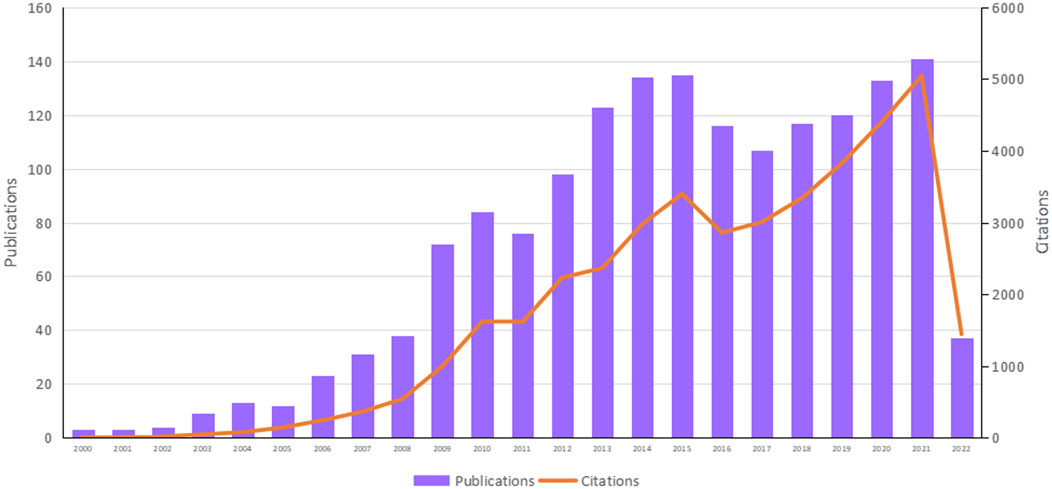
FIGURE 1. Times cited and publications over time in WBVT research since the 21st century. (Citations refer to the times cited in the year when the publication was issued).
Distribution of Regions and Co-Authorship of Countries
Based on the web of science online bibliometric analysis, the 1,629 publications on WBVT originated from 61 different countries. The top 10 countries participating in the WBVT study have 1,475 records, accounting for 91% of the total publications (Table 2). Due to cooperation among countries, the top 10 countries may publish less than 1,475 articles. The United States ranked No. 1 which contributed the most publications (n = 303, 18.6%), followed by Germany (n = 218, 13.4%), China (n = 191, 11.7%), and Spain (n = 188, 11.5%). The United States had the highest number of citations with 8,802, followed by Britain (6,549 citations), and Germany (5,640 citations). It can be seen from Table 2 that the frequency of citations is not completely proportional to the amount of literature unless a country has an absolute advantage in the literature output, such as the United States. Belgium (3,814 citations) ranked fourth in citations higher than Spain (3,746 citations), and it was not in the top 10 for literature output.
In addition to identifying the most influential countries in this field, a country cooperation analysis was also done. In the cooperative network of the countries, each element consists of a node and several links of varying thicknesses connected by the nodes (Zhao et al., 2019). In this study, the number of citations was chosen to represent the size of the nodes. The larger the node, the more influential the country is. The distance and thickness of the links between two countries describe the degree of cooperation. The minimum amount of publications of a country was set as 5. Of the 61 countries participating in the WBVT study, 38 countries met the threshold. Among the top 10 countries with the most significant publications, the United States and China (purple marked), Britain and Australia (green marked), and Canada and France (dark blue marked) were in the same cooperation network. The remaining four countries were in a cooperation network marked by different colors (Figure 2).
Distribution and Co-Authorship of Organizations
Based on the web of science online bibliometric analysis, the 1,629 publications on WBVT originated from 1,770 organizations. In addition to the League of European Research Universities (LERU) and the Helmholtz association (their members have been calculated separately), the top 10 organizations (including 11 institutions) engaged in WBVT research have 397 records, accounting for 24% of the total number of publications (Table 3). Due to the cooperation among organizations, the top 10 organizations may publish less than 397 articles. University of Cologne (n = 53, 3.3%) in Germany and the Universidade do Estado do Rio de Janeiro (n = 52, 3.2%) in Brazil headed the list of organizations that indicated that they made a considerable effort in the field of WBVT. Except for the aforementioned two organizations, the top 5 organizations that published the most literature also included: Universite de Reims Champagne-Ardenne of France (n = 36, 2.2%), European University Miguel de Cervantes of Spain (n = 35, 2.1%), and The Hong Kong Polytechnic University of China (n = 35, 2.1%). Among the top 10 organizations, four were from Germany, and two were from Spain.
VOSviewer constructs the knowledge domain map of WBVT research organizations to discover the current cooperation status of global research organizations. In this study, the node size indicates the number of literature files issued by the research organization. The link between the nodes (distance, thickness) represents the cooperation between research organizations. The minimum amount of literature was set as 8. 74 organizations met the threshold. We finally chose the most extensive set of related items consisting of 60 organizations after excluding some organizations without connection in the network. A pair of German organizations with the closest cooperation were the University of Cologne and German Sport University Cologne, with a link strength of 20. The link strengths of two pairs of organizations were followed closely, both of which were 12. They were the German Sport University Cologne and German Aerospace Center, Universidade do Estado do Rio de Janeiro in Brazil, and Istituto Auxologico Italiano (IRCCS) in Italy. Among the top 10 organizations that published the most, the University of Cologne and German Sport University Cologne were in the same cooperation network marked with orange, Universidade do Estado do Rio de Janeiro, Universite de Reims Champagne-Ardenne, and Massey University were in the same cooperation network marked with yellow, and Charite Universitatsmedizin Berlin, German Aerospace Center, and Katholieke Universiteit Leuven were in the same cooperation network marked with purple. Organizations worldwide were categorized into eleven color-coded categories (Figure 3).
Distribution of Authors and Author Cooperation
There were more than 5,500 authors counted in this bibliometric study. Bernardo-Filho, Mario, from Universidade do Estado do Rio de Janeiro in Brazil, ranked first among the top 10 productive authors with 53 publications, followed by Marin, Pedro J (41 publications) from the European University Miguel de Cervantes in Spain and De Sa-caputo, Danubia Da Cunha (39 publications) from Universidade do Estado do Rio de Janeiro. At the same time, Rittweger, Joern was the most-times co-cited author with 1,098 co-citations, followed by Cardinale, Marco (1,053 co-citations) from the University of Aberdeen in Scotland and Bosco, Carmelo (873 co-citations) from the University of Rome Tor Vergata in Italy (Table 4).
VOSviewer was used to generate a co-authors’ map displaying the distribution of the research groups in WBVT research. The minimum amount of literature of an author was set as 10. 69 authors met the threshold. Some of the 69 authors in the network were not connected. We chose the most extensive set of related items consisting of 56 authors. This knowledge domain map contained 56 nodes and 253 links (Figure 4). Each node represented an author, with the size of the node corresponding to the number of articles published by the author. The lines between the nodes indicated the cooperative relationship between authors. It can be seen from Figure 4 that researchers in the field of WBVT were composed of research groups of eight different colors. Moreover, the red research group was the core organization of the whole field, connecting the other research groups. Among the red’s core cluster, Bernardo-Filho, Mario was the author with the most literature and the most significant link strength with 240 articles.
Distribution of Source Journals and Co-Cited Journals
According to the retrieved results, publications on WBVT research were published in 491 journals. Table 5 lists the top 10 journals with more than 20 publications on this topic. Most of the publishers of these journals are in the United States and Europe. The Journal of Strength and Conditioning Research (n = 110, 6.8%) topped the list of journals by a wide margin. Journals with more than 40 publications also included the Journal of Musculoskeletal and Neuronal Interactions (n = 51, 3.1%) and the European Journal of Applied Physiology (n = 47, 2.9%), ranking second and third.
VOSviewer generated a co-citation map of cited journals that published WBVT literature. The minimum amount of co-citations of a journal were set as 100. 126 journals met the threshold. This knowledge domain map contained 126 nodes and 7,226 links (Figure 5). Each node represented a journal, with the size of the node corresponding to the co-citations of the literature published by the journal. The lines between the nodes indicated the co-cited relationship between journals. Our statistical analysis revealed 5 co-citation clusters marked by different colors, as shown in Figure 5. In the top 10 productive journals, there were seven journals in the red cluster. Half of the top 10 journals with the highest total link strengths came from the red cluster. The most frequently co-cited journals were the Journal of Strength and Conditioning Research and Medicine and Science in Sports and Exercise, with a link strength of 12,104, followed by the Journal of Strength and Conditioning Research and European Journal of Applied Physiology, with a link strength of 11,874. Another pair of co-cited journals with a link strength of over 10,000 was the Journal of Bone and Mineral Research and Bone.
Evolution and Main Path Analysis of Whole-Body Vibration Training
Through the citation chronology map generated by HistCite Pro, we can observe the history of WBVT research, the citation relationship between literature, and each research stage in critical directions. The 30 pieces of literature with the highest citation frequency in the literature collection of WBVT were selected to draw the citation chronology map. Figure 6A shows the 30 pieces of literature in chronological order, which covered 2000–2011. Each node represented a piece of literature. The size of the node was directly proportional to the frequency of citation. The line with an arrow represented the reference relationship between the nodes. The literature pointed by the arrow was the cited literature. The chronological map of the citations showed the chronological order from top to bottom in a spatial order. In Figure 6A, the total number of links was 175, and the maximum value of the local citation score (LCS) was 363. The detailed information of the 30 pieces of literature is listed in Table 6.
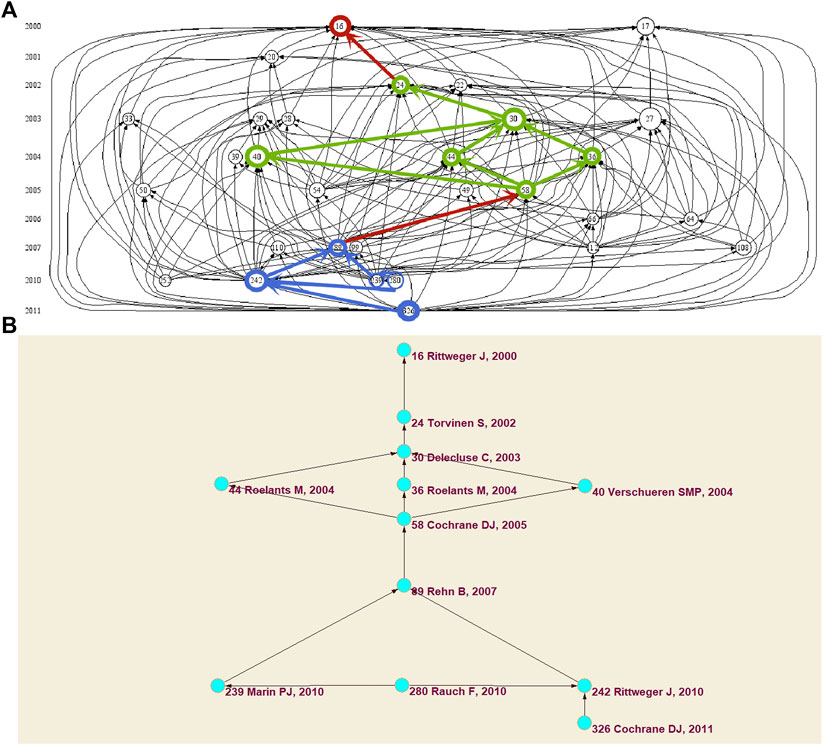
FIGURE 6. Evolution and the main path analysis of WBVT. (A) Citation chronology fusion map of the main path; (B) Main path of the citation chronology map.
The main path of the citation chronology map in the WBVT research field from 2000 to 2011 was obtained from Pajek, as shown in Figure 6B. Consistent with the citation chronology map, the node represented the literature, and the literature’s serial number, author, and publication year were marked. The direction of the arrow indicated the citation relationship between the latter and the former. The literature from 2000 to 2011 was linked through a series of nodes. The whole main path expressed the development key nodes, research directions, and development trends of WBVT research. Figure 6A intuitively shows the reference relationship between the main path and the other literature in this field.
Research Trends and Hot Spot Analyses of Whole-Body Vibration Training
We used the author keyword co-occurrence network to construct the knowledge map of WBVT research to predict the development trend of this field. The co-occurrence clustering map of author keywords varying over time by VOSviewer with a frequency greater than 12 is shown in Figure 7. After excluding duplicates, 80 high-frequency keywords were displayed in different color gradients according to the year of occurrence. The average publication age of most keywords was around 2015. The lighter the color, the more recently the word appeared. In Table 7, the keywords appearing after 2015 focused on the researchers’ attention to WBVT in recent years. It may indicate the research trend in this field to a certain extent.
We also used the clustering analysis to grasp the research hot spots of WBVT. A total of 2,509 keywords were extracted from the literature by BICOMB. At the same time, keywords with the same meaning were combined to ensure the accuracy and reliability of the data. BICOMB extracted 54 high-frequency keywords with a frequency greater than or equal to 16, and the word–paper matrix of high-frequency keywords was extracted in the matrix analysis. The word–paper matrix constructed by BICOMB was imported into gCLUTO for the biclustering analysis. In order to determine the best clustering results, biclustering was repeated several times by adjusting the number of clusters (Lu et al., 2018). The clustering results with relatively high average Isim (Internal Similarities) and relatively low average Esim (External Similarities) were selected, and the final clustering number was determined to be 5. Figure 8 is a biclustering visualization formed by high-frequency keywords for rows and co-occurrence literature for columns. There were five relatively independent and distributed mountains, representing five hot spots in WBVT research. The peaks of clusters 0 and 2 were red, indicating highly consistent research topics.

FIGURE 8. Biclustering analysis of the high-frequency word–paper matrix on WBVT. (A) Tree visualization; (B) Mountain visualization.
Discussion
The present study is the first bibliometric analysis for WBVT. We observed a rapid increase in the number of publications and citations from 2000 to 2022, which indicates that WBVT has received increasing attention as a method of exercise rehabilitation.
Through the bibliometric analysis of the countries where the literature is located, we can understand the attention and contribution of different countries to the relevant research fields. In addition to identifying the most influential countries in this field, a country cooperation analysis reflects the degree of co-authorship between regions (Zhao et al., 2019). Spain had the highest total link strength in the present study, followed by Germany, Britain, and the United States. The literature output of these four countries ranked among the top 5 in the world. China ranked third in output, but the total link strength was low, indicating that there was relatively little international cooperation. The co-authorship between the United States and Spain was the closest. Brazil also had close cooperation with France and Spain, closely following the United States and Spain. Germany and Britain were slightly behind them, ranking fourth in link strength. The total link strength of France was 116, but the frequency of citations was only 881. Although Belgium’s total link strength was only 35, the times cited had reached 3,814. There seems to be no absolute relationship between international cooperation and influence.
Analyzing the distribution and co-authorship of research institutions can provide a reference basis for academic exchanges and selecting, training, and promoting talents. To further discover the current cooperation status of global research organizations, the knowledge domain map of WBVT research organizations was constructed. Among the top 10 organizations, Charite Universitatsmedizin Berlin, German Sport University Cologne, and German Aerospace Center were all from Germany. So, the aforementioned research institutions in Germany may be the better choice for academic exchanges and talent training. This study showed that the frequency of cooperation between WBVT research organizations in the world was low. It is worth noting that the cooperation of domestic organizations still dominated the form of cooperation. The closest cooperation was between the University of Cologne and German Sport University Cologne. There were only a few relatively stable cooperation groups with countries as units in the world. Therefore, researchers worldwide should increase communication and promote global cooperation for a more rapid development of WBVT research.
The research on the distribution of authors can grasp the breadth and depth of research in this field. The distribution of authors is the epitome of scientific research. The prosperity and development of WBVT research are inseparable from a group of core researchers with a solid theoretical foundation and rich achievements. We generated a co-authors’ map displaying the distribution of the research groups in WBVT research. Bernardo-Filho, Mario, who had the most literature outputs and a total link strength of 240 could play a critical role in the international cooperation and discipline development of the WBVT field. However, we found that among the top 10 authors cited frequently, no authors were in the red cluster of high- productivity authors. The most frequently cited author was Verschueren, Sabine (2,883 citations) from Katholieke Universiteit Leuven of Belgium in the yellow cluster, followed by Rittweger, Joern (2,575 citations) from the Free University of Berlin in the dark blue cluster. Although the number of some cluster members was small and the literature output was not ranked in the top 10, the citation frequency of all co-authors in the cluster was relatively high. For example, there were only two co-authors (Rubin, Clinton T, and Judex, Stefan from SUNY Stony Brook University in the United States) in the brown cluster, all cited in the top 10.
Analyzing the sources of publications can help the researchers in the field of WBVT choose a better submission scheme and help researchers select and read appropriate references to improve the pertinence and effectiveness of WBVT research. The vital knowledge source and core journals in an academic field can be mastered by analyzing the co-citation of journals in that field. We generated a co-citation map of cited journals that published the WBVT literature. The most frequently co-cited journals were all from the red cluster. Another pair of frequently co-cited journals was the Journal of Bone and Mineral Research and Bone from the yellow cluster. They were not in the top 10, but the co-cited analysis showed that the two journals had a specific influence in this field. Researchers in WBVT may obtain valuable information about WBVT from these journals. These journals also became the primary choice for the submission on WBVT.
The main path described the knowledge bases of WBVT research. In the present study, the main path contained 12 key nodes, starting from Rittweger’s study on the acute physiological effects of WBVT in 2000 (Rittweger et al., 2000). WBVT research was basically maintained on one main path, which was divided into two stages. The first stage ran from 2002 to 2005 and contained six important node literature pieces. This stage began with Torvinen’s research on the effects of whole-body vibrations on muscle performance and body balance in 2002 (Torvinen et al., 2002). In 2003, after Delecluse proposed that WBVT could increase female knee-extensor strength (Delecluse et al., 2003), this route was divided into three branches in 2004. These three branches were to study the effects of WBVT on women’s athletic ability. Two of these studies came from Roelants, one on muscle strength (Roelants et al., 2004a) and the other on the strength of knee-extension and the speed of movement (Roelants et al., 2004b). The third was Verschueren’s research on hip density and postural control in addition to muscle strength (Verschueren et al., 2004). The three branches converged again into the main path in 2005. That year, Cochrane found that acute WBVT improved flexibility performance and vertical jump in female hockey athletes (Cochrane and Stannard, 2005). From 2007 to 2011, the second stage contained five important node literature pieces, which began with the effect of WBVT on leg muscle performance proposed by Rehn (Rehn et al., 2007). Then, this stage was divided into two branches in 2010. Rittweger reviewed the research process of WBVT from theory to practical application and discussed its possible potential applications in sports and medicine (Rittweger, 2010). The other branch was Marin’s research on the effect of vibration training on muscle strength (Marín and Rhea, 2010). Based on these two studies, the International Society of Musculoskeletal and Neuronal Interactions (ISMNI) invited experts in this field to provide suggestions on how to describe interventions in the reports about WBV treatment studies (Rauch et al., 2010). In 2011, Cochrane continued to support Rittweger’s research on the potential benefits of WBVT and further proposed that the study should focus on the optimal dose relationship of amplitude, frequency, and duration in different populations (Cochrane, 2011). A map of the critical literature nodes of the main path obtained by Pajek to the citation chronology map obtained by HistCite Pro could help to obtain the citation chronology fusion map of the main path (Dan et al., 2021). We next obtained the citation chronology fusion map of the main path. We found that the literature on the main path may not be cited most frequently. However, the literature put forward critical theories or innovative concepts in WBVT research (Dong and Guo, 2010).
Keywords can express the literature theme, and the clustering analysis of co-occurrence keywords can reveal the hot spots in this research field (Zhao et al., 2019). Through the age of keywords, we can predict the research trend of a discipline in recent years. The author keywords are the most primitive natural language proposed by the authors of the publications without standardization, which may best represent the emerging theme of a subject. In this study, we found that the early studies were focused on postural control, balance, bone mineral density, and body composition, which indicated that many studies aimed to find evidence to support the use of WBVT to improve athletic performance in the past (Beck, 2015; Cloak et al., 2016; Gómez-Bruton et al., 2017). The keywords used in more recent articles were obesity, stroke, pulmonary rehabilitation, sarcopenia, and quality of life, which revealed that WBVT was studied for the application in the exercise rehabilitation of several chronic diseases in recent years (Pleguezuelos et al., 2013; Silva et al., 2014; Alvarez-Alvarado et al., 2017; Wu et al., 2020). Studies related to the previous keyword “osteoarthritis” and the recent keyword “knee osteoarthritis” showed that the application of WBVT in osteoarthritis has always been the focus. Our data showed that the research trends in WBVT studies identified by analyzing the keywords in terms of time were exercise rehabilitation of chronic diseases, especially knee osteoarthritis in the future. A biclustering analysis is to classify individuals or objects according to their similarities and help us grasp research hot spots and development trends. According to the clustering results, the present study obtained five hot spots in WBVT research. The main keywords involved in the five hot spots were aging, exercise, sarcopenia, osteoporosis, stroke, low back pain, osteoarthritis, chronic obstructive pulmonary disease, quality of life, etc. It is confirmed that the exercise rehabilitation of several aging chronic diseases was the hot spot of WBVT.
The present study has some limitations. First, we mainly conducted the searches in WoSCC. Combining the results with those from other databases, such as PubMed and Scopus, would be better. Second, due to the collection characteristics of WoSCC, English literature accounts for 97% of the final collected literature. To some extent, this ignores the literature research published in other languages. Third, the number of clusters in the network analysis can be affected by the author’s subjective viewpoint. Fourth, we might have underestimated the contribution of recently published studies because of their low citation frequency. Fifth, due to the authors’ duplicate names and authors’ multiple units, there might be statistical errors in analyzing the authors and organizations.
Conclusion
In conclusion, the present study provided valuable data for potential collaborations among researchers and institutions and identified hot spots and trends in the research on WBVT. Our data will contribute to identifying the core target diseases of WBVT and providing vital insights for researchers in this field.
Data Availability Statement
The original contributions presented in the study are included in the article/Supplementary Material; further inquiries can be directed to the corresponding author.
Author Contributions
DD, SX, and MS designed the study. DD, DX, SH, and LC collected the literature and drafted the initial manuscript. SC and YY assisted in the preparation of the figures and tables. SX revised the manuscript and edited the language. All authors approved the final manuscript as submitted and are accountable for all aspects of the work.
Funding
This work was supported by the Liaoning Social Science Planning Fund (Grant No. L21BTQ008), Science Foundation of Liaoning Provincial Department of Education (Grant No. QNRW2020005), and China Medical University Youth Backbone Support Program (Humanities and Social Sciences Category A, Grant No. QGRA2018009).
Conflict of Interest
The authors declare that the research was conducted in the absence of any commercial or financial relationships that could be construed as a potential conflict of interest.
Publisher’s Note
All claims expressed in this article are solely those of the authors and do not necessarily represent those of their affiliated organizations, or those of the publisher, the editors, and the reviewers. Any product that may be evaluated in this article, or claim that may be made by its manufacturer, is not guaranteed or endorsed by the publisher.
References
Alvarez-Alvarado, S., Jaime, S. J., Ormsbee, M. J., Campbell, J. C., Post, J., Pacilio, J., et al. (2017). Benefits of Whole-Body Vibration Training on Arterial Function and Muscle Strength in Young Overweight/obese Women. Hypertens. Res. 40 (5), 487–492. doi:10.1038/hr.2016.178
Annino, G., Iellamo, F., Palazzo, F., Fusco, A., Lombardo, M., Campoli, F., et al. (2017). Acute Changes in Neuromuscular Activity in Vertical Jump and Flexibility after Exposure to Whole Body Vibration. Med. Baltim. 96 (33), e7629. doi:10.1097/MD.0000000000007629
Arias, P., Chouza, M., Vivas, J., and Cudeiro, J. (2009). Effect of Whole Body Vibration in Parkinson's Disease: a Controlled Study. Mov. Disord. 24 (6), 891–898. doi:10.1002/mds.22468
Arunachalam, S., and Viswanathan, B. (2008). A Historiographic Analysis of Fuel-Cell Research in Asia–China Racing Ahead. Curr. Sci. 95, 36–49.
Batagelj, V., and Mrvar, A. (2004). “Pajek - Analysis and Visualization of Large Networks,” in Graph Drawing Software (Berlin, Heidelberg: Springer), 77–103. doi:10.1007/978-3-642-18638-7_4
Beck, B. R. (2015). Vibration Therapy to Prevent Bone Loss and Falls: Mechanisms and Efficacy. Curr. Osteoporos. Rep. 13 (6), 381–389. doi:10.1007/s11914-015-0294-8
Bleeker, M. W. P., De Groot, P. C. E., Rongen, G. A., Rittweger, J., Felsenberg, D., Smits, P., et al. (2005). Vascular Adaptation to Deconditioning and the Effect of an Exercise Countermeasure: Results of the Berlin Bed Rest Study. J. Appl. physiology 99 (4), 1293–1300. doi:10.1152/japplphysiol.00118.2005
Boyack, K. W., and Klavans, R. (2010). Co-citation Analysis, Bibliographic Coupling, and Direct Citation: Which Citation Approach Represents the Research Front Most Accurately? J. Am. Soc. Inf. Sci. 61 (12), 2389–2404. doi:10.1002/asi.21419
Cloak, R., Nevill, A., and Wyon, M. (2016). The Acute Effects of Vibration Training on Balance and Stability Amongst Soccer Players. Eur. J. sport Sci. 16 (1), 20–26. doi:10.1080/17461391.2014.973912
Cochrane, D. J., and Stannard, S. R. (2005). Acute Whole Body Vibration Training Increases Vertical Jump and Flexibility Performance in Elite Female Field Hockey Players. Br. J. Sports Med. 39 (11), 860–865. doi:10.1136/bjsm.2005.019950
Cochrane, D. J. (2011). Vibration Exercise: the Potential Benefits. Int. J. Sports Med. 32 (02), 75–99. doi:10.1055/s-0030-1268010
Dan, X., Ying, Y., Shuang, H., and Shuang, X. (2021). Research on the Global Development of Bioinformatics Based on the Core Journals of SCIE Br. Libraly J. 40 (9), 112. doi:10.13663/j.cnki.lj.2021.09.014
Delecluse, C., Roelants, M., and Verschueren, S. (2003). Strength Increase after Whole-Body Vibration Compared with Resistance Training. Med. Sci. Sports Exerc. 35 (6), 1033–1041. doi:10.1249/01.mss.0000069752.96438.b0
Dong, L. P., and Guo, J. J. (2010). Main Path Analysis on Human Embryonic Stem Cell Citation Chronological Chart Using Histcite. J. Med. Inf. 31 (11), 38–40+9.
Gao, Z., Zhang, J., Liu, G.-F., and Ji, L.-X. (2021). Research Trends from 2010 to 2020 for Pain Treatment with Acupuncture: a Bibliometric Analysis. Jpr Vol. 14, 941–952. doi:10.2147/jpr.s300911
Godinez, A., Liston, D. B., Ayzenberg, R., Toscano, W. B., Cowings, P. A., and Stone, L. S. (2014). G-loading and Vibration Effects on Heart and Respiration Rates. Aviat. space Environ. Med. 85 (9), 949–953. doi:10.3357/asem.4015.2014
Gómez-Bruton, A., González-Agüero, A., Matute-Llorente, A., Julián, C., Lozano-Berges, G., Gómez-Cabello, A., et al. (2017). Do 6 months of Whole-Body Vibration Training Improve Lean Mass and Bone Mass Acquisition of Adolescent Swimmers? Archives Osteoporos. 12 (1), 1–11. doi:10.1007/s11657-017-0362-z
Jain, S., Basavaraj, P., Singla, A., Singh, K., Kundu, H., Vashishtha, V., et al. (2015). Bibliometric Analysis of Journal of Clinical and Diagnostic Research (Dentistry Section; 2007-2014). J. Clin. Diagn Res. 9 (4), ZC47–51. doi:10.7860/JCDR/2015/11994.5834
Lei, C., Wei, L., Lei, Y., Han, Z., Yuefang, H., Yingna, H., et al. (2008). Development of a Text Mining System Based on the Co-occurrence of Bibliographic Items in Literature Databases. Data Analysis Knowl. Discov. 24 (8), 70–75.
Liu, Y., Wang, Y., and Li, M. (2017). An Empirical Analysis for the Applicability of the Methods of Definition of High-Frequency Words in Word Frequency Analysis. Digit. Libr. Forum, 37, 42–49.
Lu, K., Yu, S., Yu, M., Sun, D., Huang, Z., Xing, H., et al. (2018). Bibliometric Analysis of Tumor Immunotherapy Studies. Med. Sci. Monit. 24, 3405–3414. doi:10.12659/msm.910724
Machado, A., García-López, D., González-Gallego, J., and Garatachea, N. (2010). Whole-body Vibration Training Increases Muscle Strength and Mass in Older Women: a Randomized-Controlled Trial. Scand. J. Med. Sci. Sports 20 (2), 200–207. doi:10.1111/j.1600-0838.2009.00919.x
Marín, P. J., and Rhea, M. R. (2010). Effects of Vibration Training on Muscle Strength: a Meta-Analysis. J. Strength & Cond. Res. 24 (2), 548–556. doi:10.1519/JSC.0b013e3181c09d22
Olczyk, M. (2016). Bibliometric Approach to Tracking the Concept of International Competitiveness. J. Bus. Econ. Manag. 17 (6), 945–959. doi:10.3846/16111699.2016.1236035
Ormerod, R. J. (2010). Research Contribution: Citation and Content Analysis. J. Operational Res. Soc. 61 (4), 705–707. doi:10.1057/jors.2009.166
Park, H., Lee, I.-S., Lee, H., and Chae, Y. (2020). Bibliometric Analysis of Moxibustion Research Trends over the Past 20 Years. Jcm 9 (5), 1254. doi:10.3390/jcm9051254
Park, J., Kim, H., Kim, K.-W., Cho, J.-H., Chung, W.-S., and Song, M.-Y. (2021). Bibliometric Analysis of Research Trends on Acupuncture for Neck Pain Treatment over the Past 20 Years. Jpr Vol. 14, 3207–3221. doi:10.2147/jpr.s331514
Pleguezuelos, E., Pérez, M. E., Guirao, L., Samitier, B., Costea, M., Ortega, P., et al. (2013). Effects of Whole Body Vibration Training in Patients with Severe Chronic Obstructive Pulmonary Disease. Respirology 18 (6), 1028–1034. doi:10.1111/resp.12122
Qiu, C., Chui, E. C. S., Chow, S. K. H., Cheung, W.-H., and Wong, R. M. Y. (2022). The Effects of Whole-Body Vibration Therapy on Knee Osteoarthritis: A Systematic Review and Meta-Analysis of Randomized Controlled Trials. J. Rehabilitation Med. 54, jrm00266. doi:10.2340/jrm.v54.2032
Qiu, J.-P., Dong, K., and Yu, H.-Q. (2014). Comparative Study on Structure and Correlation Among Author Co-occurrence Networks in Bibliometrics. Scientometrics 101 (2), 1345–1360. doi:10.1007/s11192-014-1315-6
Rasmussen, M., Deshpande, M. S., Karypis, G., Johnson, J., Crow, J. A., Retzel, E. F., et al. (2003). wCLUTO: A Web-Enabled Clustering Toolkit. Plant Physio. 133 (2), 510–516. doi:10.1104/pp.103.024885
Rauch, F., Sievanen, H., Boonen, S., Cardinale, M., Degens, H., Felsenberg, D., et al. (2010). Reporting Whole-Body Vibration Intervention Studies: Recommendations of the International Society of Musculoskeletal and Neuronal Interactions. J. Musculoskelet. Neuronal Interact. 10, 193–198.
Rehn, B., Lidström, J., Skoglund, J., and Lindström, B. (2007). Effects on Leg Muscular Performance from Whole-Body Vibration Exercise: a Systematic Review. Scand. J. Med. Sci. Sports 17 (1), 2–11. doi:10.1111/j.1600-0838.2006.00578.x
Rittweger, J., Beller, G., and Felsenberg, D. (2000). Acute Physiological Effects of Exhaustive Whole-Body Vibration Exercise in Man. Clin. Physiol. 20 (2), 134–142. doi:10.1046/j.1365-2281.2000.00238.x
Rittweger, J. (2010). Vibration as an Exercise Modality: How it May Work, and what its Potential Might Be. Eur. J. Appl. Physiol. 108 (5), 877–904. doi:10.1007/s00421-009-1303-3
Rodríguez-Reyes, G., García-Ulloa, A. C., Hernández-Jiménez, S., Alessi-Montero, A., Carrera, L. N., Rojas-Torres, F., et al. (2021). Effect of Whole-Body Vibration Training on Transcutaneous Oxygen Levels of the Foot in Patients with Type 2 Diabetes: A Randomized Controlled Trial. J. biomechanics 139, 110871. doi:10.1016/j.jbiomech.2021.110871
Roelants, M., Delecluse, C., Goris, M., and Verschueren, S. (2004a). Effects of 24 Weeks of Whole Body Vibration Training on Body Composition and Muscle Strength in Untrained Females. Int. J. Sports Med. 25 (01), 1–5. doi:10.1055/s-2003-45238
Roelants, M., Delecluse, C., and Verschueren, S. M. (2004b). Whole-Body-Vibration Training Increases Knee-Extension Strength and Speed of Movement in Older Women. J. Am. Geriatrics Soc. 52 (6), 901–908. doi:10.1111/j.1532-5415.2004.52256.x
Silva, A. T., Dias, M. P. F., Calixto, R., Carone, A. L., Martinez, B. B., Silva, A. M., et al. (2014). Acute Effects of Whole-Body Vibration on the Motor Function of Patients with Stroke. Am. J. Phys. Med. Rehabilitation 93 (4), 310–319. doi:10.1097/phm.0000000000000042
Song, N., Liu, X., Feng, Q., Xu, M., Lan, X., Li, M., et al. (2019). Whole Body Vibration Triggers a Change in the Mutual Shaping State of Intestinal Microbiota and Body's Immunity. Front. Bioeng. Biotechnol. 7, 377. doi:10.3389/fbioe.2019.00377
Tankisheva, E., Bogaerts, A., Boonen, S., Feys, H., and Verschueren, S. (2014). Effects of Intensive Whole-Body Vibration Training on Muscle Strength and Balance in Adults with Chronic Stroke: a Randomized Controlled Pilot Study. Archives Phys. Med. rehabilitation 95 (3), 439–446. doi:10.1016/j.apmr.2013.09.009
Thompson, D. F., and Walker, C. K. (2015). A Descriptive and Historical Review of Bibliometrics with Applications to Medical Sciences. Pharmacotherapy 35 (6), 551–559. doi:10.1002/phar.1586
Torvinen, S., Kannus, P., Sievanen, H., Jarvinen, T. A., Pasanen, M., Kontulainen, S., et al. (2002). Effect of Four-Month Vertical Whole Body Vibration on Performance and Balance. Med. Sci. Sports Exerc. 34 (9), 1523–1528. doi:10.1097/00005768-200209000-00020
Van Eck, N. J., and Waltman, L. (2010). Software Survey: VOSviewer, a Computer Program for Bibliometric Mapping. scientometrics 84 (2), 523–538. doi:10.1007/s11192-009-0146-3
Verschueren, S. M., Roelants, M., Delecluse, C., Swinnen, S., Vanderschueren, D., and Boonen, S. (2004). Effect of 6-month Whole Body Vibration Training on Hip Density, Muscle Strength, and Postural Control in Postmenopausal Women: a Randomized Controlled Pilot Study. J. Bone Min. Res. 19 (3), 352–359. doi:10.1359/JBMR.0301245
Wang, W., Wang, S., Lin, W., Li, X., Andersen, L. L., and Wang, Y. (2020). Efficacy of Whole Body Vibration Therapy on Pain and Functional Ability in People with Non-specific Low Back Pain: a Systematic Review. BMC Complement. Med. Ther. 20 (1), 158–212. doi:10.1186/s12906-020-02948-x
Wei, N., and Cai, M. (2021). Optimal Frequency of Whole Body Vibration Training for Improving Balance and Physical Performance in the Older People with Chronic Stroke: A Randomized Controlled Trial. Clin. Rehabil. 36, 342–349, . doi:10.1177/02692155211050564
Wu, H., Cheng, K., Guo, Q., Yang, W., Tong, L., Wang, Y., et al. (2021a). Mapping Knowledge Structure and Themes Trends of Osteoporosis in Rheumatoid Arthritis: A Bibliometric Analysis. Front. Med. (Lausanne) 8. doi:10.3389/fmed.2021.787228
Wu, H., Sun, Z., Tong, L., Wang, Y., Yan, H., Sun, Z., et al. (2021b). Bibliometric Analysis of Global Research Trends on Male Osteoporosis: A Neglected Field Deserves More Attention. Arch. Osteoporos 16 (1), 154. doi:10.1007/s11657-021-01016-2
Wu, S., Ning, H. T., Xiao, S. M., Hu, M. Y., Wu, X. Y., Deng, H. W., et al. (2020). Effects of Vibration Therapy on Muscle Mass, Muscle Strength and Physical Function in Older Adults with Sarcopenia: a Systematic Review and Meta-Analysis. Eur. Rev. Aging Phys. Act. 17 (1), 14–12. doi:10.1186/s11556-020-00247-5
Xiang, H., Li, J., Li, B., Tan, Q., and Cai, G. (2021). Trends of Acupuncture Therapy on Depression from 2011 to 2020: A Bibliometric Analysis. Front. Psychol. 12, 721872. doi:10.3389/fpsyg.2021.721872
Zhai, K., Ma, W., and Huang, T. (2021). Hot Spots and Trends in Knee Revision Research since the 21st Century: a Bibliometric Analysis. Ann. Transl. Med. 9 (5), 388. doi:10.21037/atm-20-3969
Zhao, F., Du, F., Shi, D., Zhou, W., Jiang, Y., and Ma, L. (2019). Mapping Research Trends of Retinal Vein Occlusion from 2009 to 2018: a Bibliometric Analysis. PeerJ 7, e7603. doi:10.7717/peerj.7603
Keywords: whole-body vibration training (WBVT), bibliometric analysis, visualization, citation chronology map, main path analysis, hot spots, biclustering analysis
Citation: Dong D, Sun M, Xu D, Han S, Cui L, Cao S, Yang Y and Xu S (2022) Mapping the Hot Spots and Evolution Main Path of Whole-Body Vibration Training Since the 21st Century: A Bibliometric Analysis. Front. Bioeng. Biotechnol. 10:920846. doi: 10.3389/fbioe.2022.920846
Received: 15 April 2022; Accepted: 06 June 2022;
Published: 11 July 2022.
Edited by:
Yang Liu, Hong Kong Polytechnic University, Hong Kong SAR, ChinaCopyright © 2022 Dong, Sun, Xu, Han, Cui, Cao, Yang and Xu. This is an open-access article distributed under the terms of the Creative Commons Attribution License (CC BY). The use, distribution or reproduction in other forums is permitted, provided the original author(s) and the copyright owner(s) are credited and that the original publication in this journal is cited, in accordance with accepted academic practice. No use, distribution or reproduction is permitted which does not comply with these terms.
*Correspondence: Shuang Xu, c3h1QGNtdS5lZHUuY24=
 Dan Dong1
Dan Dong1 Shuang Xu
Shuang Xu
